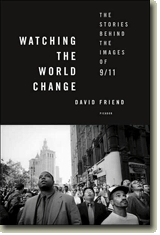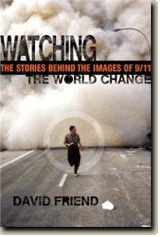December 2007 Archives
« Previous · Home · Next »
December 26, 2007
2008, WATERSHED YEAR
Christmas week, and the beckoning of the new year, give many of us reason to reassess the past twelve months and to recalibrate our priorities. I'm certainly taking a gut check (pound-wise), reality check (in terms of my social interactions), stress check, family infusion, work retooling, thankfulness tally, and spiritual gauge (in terms of my inner being and my stance on the Big Issues). What's more, I see 2008 as a watershed year in many larger ways, especially as America goes about choosing a new president and as the wars in Iraq and Afghanistan grind on.
It's also a pivotal year for us Chicago Cubs fans, who begin a dubious centennial: 100 years since our last World Series victory -- over the Detroit Tigers -- in 1908! (For the definitive history of baseball's "grandest season," pick up Cait Murphy's new book, Crazy '08.)
This week, though, is also a time to just let it all loose. To that end: a Polar Bear Party at my sister- and brother-in-law Joann and Michael Rooney's home, in New Rochelle, New York, at which three dozen hearty souls (10 to 12 aren't pictured here) jumped into the Long Island Sound. (My son, Sam, is in the front row of the smiling scrum, below, sixth from the left, in the tan trunks.) Water temperature: a beautiful 41 degrees.

PHOTO BY LIZ GARLAND SAUER
December 23, 2007
AVAILABLE LIGHT
My thanks to Cheryl Reeves, who recently reviewed Watching the World Change on the FEMINIST REVIEW BLOG. Quoth Reeves, in part:
“In David Friend’s compelling and movingly written examination of the photographic legacy of the terror-filled day of September 11th, the light is a protean character—bordering on the mystical. As it happened, precisely because the light was fantastic, photographers (amateur and professional) were out en masse on the city streets. Unwittingly, they found themselves in a unique position to record history as it unfolded when the first fireball exploded and then the second and then the gray-black smoking clouds roiled above blotting out the sun and later, when the choking dust clouds raced below through the streets of downtown Manhattan.
“It is striking to learn how many amateur photographs made it into the major newspapers and magazines. To be in the wrong place at the right time and get the tragic poetic angle was everything. More striking still, to learn how many of these people kept shooting at their own peril. More than a few said they felt as if God was with them, and they were merely an instrument.”
THE NAUDET BROTHERS' SPIRITUAL QUEST
A REMINDER: TONIGHT, PLEASE TUNE IN...
Gedeon and Jules Naudet were the French filmmakers behind the 2002 CBS special 9/11, which aired in 140 nations, raised more than $2 million for the Uniformed Firefighters Association Scholarship Fund and earned both a Peabody and an Emmy Award (for best documentary). I served as an executive producer of the program and wrote about the Naudet brothers' 9/11 ordeal in Watching the World Change (pages 182-195), extensively and exclusively, thanks to our having been family friends for many, many years.
TONIGHT, CBS will air the Naudets' latest effort (check your local listings). Their documentary, called In God's Name, which has been getting good buzz in the press, was two years in the making. It focuses on the daily lives and inner beliefs of the 12 leaders of the 12 major world religions. The brothers and CBS producer Susan Zirinksy, judging from the rough cuts and trailer I've seen, have produced a truly unique and unprecedented film -- visiting these spiritual figures in their prayer settings, in their bedrooms, and going about their daily rituals. Each religious figure was asked to address fundamental questions about his or her faith. The documentary contains breathtaking footage from around the globe and will take viewers on a spiritual pilgrimage that has the intimacy of a religious retreat and yet the sweep of a David Leen or Richard Attenborough epic.
For a slideshow of images of the Naudets' dozen subjects, visit this NEWSWEEK link.

Photo by Stephan Crasneanscki
for “In God’s Name” by Gedeon and Jules Naudet/CBS
...And while we're on the spiritual path, I'd like to offer best wishes for the holidays, and the New Year, to the community of readers who visit this blog.
Many thanks for stopping by from time to time.
December 15, 2007
WATERGATE VS. WATERBOARD
Government officials are up to their ears in illegal activities...The Congress begins investigating but is hampered at every turn by a foot-dragging White House...Soon, evidence surfaces that the actions were recorded on tape, the existence of which (or destruction of which) could seriously implicate those involved.
Sound familiar? In the current scenario the government officials worked for the C.I.A., following a Bush administration-sanctioned torture policy. The dirty deeds: the torture of two al-Qaeda henchman by U.S. intelligence operatives. The tape: videos of that torture, which were subsequently destroyed.
Of course, we’ve seen this same snuff film somewhere before, haven’t we? From the Abu Ghraib scandal (in which digital photos chronicled American soldiers’ abuse of Iraqi detainees) to the Iran-contra scandal (in which early-generation e-mails showed how rogue operatives channeled profits from illegal arms sales to Iran into the coffers of the Nicaraguan contas) to the Watergate scandal (in which the president himself audiotaped all manner of malfeasance) it has been, as they say, déjà vu all over again.
The difference, though, between Le Scandals Watergate and Waterboard: In Nixon’s case, when White House and Justice Department lawyers encouraged the president to save the tapes in order to avoid obstruction of justice charges, he did (although he may very well have encouraged his secretary, Rose Mary Woods, to deliberately erase 18-and-a-half damning minutes). In the latest mess, even though White House and Justice Department lawyers cautioned the Agency to save its tapes, the C.I.A., per usual, did what it pleased – and deep-sixed them.
Now, of course, the president and the Justice Department, the same dynamic duo that brought us the post-9/11 torture policy in the first place, are coming up with tortured logic to justify non-compliance with Congressional investigators and implying that the tapes’ destruction is moot anyway because they never had to be turned over in the first place.
What they fail to realize, however, is a lesson sorely learned in the digital age: Whenever data is destroyed, another copy mysteriously surfaces.
My guess is that we haven’t seen the end of the torture tapes. Somewhere, in some safety deposit box or closet or attic, or deep in the recesses of a rogue hard drive, someone – an underling, a supervisor, or an agent (whether proud of his actions, enraged by the actions of a colleague, or hoping to cover his ass) - made a dupe that he’s been squirreling away for three or four years, a copy of which will inevitably find its way into Congressional hands (or wind its way up onto YouTube), making dupes of everyone involved.
Patience, patience. In this age when data is forever-stored and passed along, like traces of DNA in a genome, it wouldn't surprise me if somehow someone somewhere will unload that damning cache.
December 7, 2007
CAUSE AND EFFECT
To view one of the most compelling photo-essay presentations I have seen in a long, long time, please visit: DEFINITIVE STORIES. Click on the lower left-hand button and you will visit the driest inhabited place on Earth (war-torn and starvation-plagued Sudan) and the most imperiled accumulation of glaciers (Antarctica). You will also get a sense of fragility and interconnectedness of our planet and the impact of climate change on two extreme locales: 12 Degrees N x 23 Degrees E vs. 64 Degrees S x 60 Degrees E.
Photographs by Colin Finlay.
GET SMACKED
Into every life, a little levity must fall. Not that levity has much of a place on a blog centered around a book devoted to "the stories behind the images of 9/11." Even so, since much of what I write about concerns visual culture, I thought I would let blog readers know about a new Web-based service that I am advising.
It is called ComedySmack -- the brainchild of a friend of mine named David Moore who is, by night, a standup comic at New York's legendary Caroline's Comedy Club, and, by day, an entrepreneur and bon vivant.
Each weekday, a discerning clan of humor hunters-and-gatherers scour the Net, along with new films, books, television shows, comedy clubs, the news wires, etc., to come up with three choice nuggets of Grade-A comedy. I encourage everyone to sign up, for free, at the link above, and you will begin receiving your Morning Dose of Crazy, in the form of a discrete email blast.
Get smacked.
Well, as long as I'm at it....please, visit Diversity Matters, the Web site and weekly radio show/podcast of my brother, Dr. Richard Friend, that explores myriad issues of diversity in modern life.

December 2, 2007
CHICKEN LITTLES OF LIT
CHICKEN LITTLES OF LIT At dinner last night, Simon & Schuster editor Mark Gompertz defended the long-term health of books in print. “We’ve been hearing about the death knell of 'The Book' for thirty years now,” he remarked, “at least as long as I’ve been in publishing.” So we have. And while recent statistics support the fact that there has indeed been a sharp downturn in American literacy (last month an NEA study showed a steep decline in recreational reading) and that book clubs and the Harry Potter craze seem to have been exceptions instead of trend-setting breakthroughs, I have a hard time believing the Chicken Littles of Lit.
While I agree that the digital swords of Damocles are slashing everywhere (the Web has doomed newspapers; file-sharing and the iPod have doomed the music biz; 24/7 news has doomed the newsmagazine [Quoth lad-mag maven Felix Dennis to Times's columnist David Carr last week on the absurdity of current newsmagazines: "''Golfing for Cats With Jesus Who Has Cancer' is not something that people need to know about"]), the trusty, dusty Book, based on a 500-year-old technology, remains the most portable, reliable, sustainable, and ceaselessly retrievable vessel for long-form entertainment, bar none. The book ain’t goin’ nowhere any time soon, even if the annual profit margins of the book trade (as with every mainstream media business) are becoming as slim as the edge of an Amazon gift card.
Even so, I have a sense of foreboding, really, when I realize that so much of the cultural commentary that I absorb these days, online and offline and in conversation, reminds me of how the Web is eroding traditional media. I’m currently digesting Sarah Greenough’s exhaustive Modern Art and America: Alfred Stieglitz and His New York Galleries, a companion volume to the 2001 exhibition at the National Gallery of Art, in Washington, D.C. In an essay in Greenough’s book by Anne McCauley, “Edward Steichen: Artist, Impresario, Friend,” I’m reminded how photographer Edward Steichen in 1906 – a full century ago – felt compelled to flee to Paris to find a culture that was respectful of, well, culture itself, characterized by an urge to express and experiment that was pulsing through the city’s salons and art galleries and cafes.
Writes McCauley: “Like the British socialist H. G. Wells who in 1906 found himself doubting the wisdom and sustainability of unfettered material progress, Steichen returned to Europe to find a culture that valued the spiritual and the beautiful.” Steichen was on the very threshold of modern art and music and dance and literature and theater. (Not to mention his role, in the 20s, in taking iconic photographic portraits of key players in an emergent medium, motion pictures, a new art form that sprang from the experiments of French photo masters in the previous century.)
When reading the Steichen passage, oddly enough, I found myself jumping ahead 102 years and mourning a society and a system that have laid the groundwork for the Hollywood writer’s strike, a standoff that underscores the tenuous hold creators have over their creations in the electronic age, pitting scribes against studios for the rights to digital iterations of their work.
The question today becomes: Is it all about the work (meaning: the art)? Or is it all about the platform for delivering the art? Is it all about the prophets or the profits? The aesthetes or the suits?
MAG PILE. I'm just getting to my groaning pile of backlogged magazines. I recommend Walter Kirn’s brilliant essay decrying “multitasking” in last month’s 150th anniversary of The Atlantic Monthly (150 years!! Why, oh, why did they decamp from clear-eyed Boston to dreary D.C.?!) Among Kirn’s pearls: “[P]ersonal digital assistants…in my opinion, turned multitasking from a habit into a pathology, which the advent of Bluetooth then rendered fatal and the spread of wireless broadband made communicable.”
Speaking of "It's-All-About-Profit": Why does this weekend's New York Times Book Review feature a coffee-table book on the devastation of storms (hurricanes, tornadoes, etc.) as a "Holiday Book: Weather" (touted in a rather cheery typeface) and why does a Hacehtte Books ad prominently display, without a hint of irony, my colleague Christopher Hitchens's bestselling book for non-believers, God is Not Great, as a HOLIDAY Book (derivation: Holy Day)? We've clearly lost all perspective but the commercial.
And while we’re at it, in the same issue, Paul Elie (Full Disclosure: Elie happens to be the editor who brought Watching the World Change to the printed page) tells why theologian Reinhold Niebuhr, a generation after his death, still holds sway over the American soul in these troubled times. Elie’s examination of the wisdom and prescience of Niebuhr (talk about a prophet!) reminded me, oddly enough, that it was a quote about Niebuhr that subtly solidified my support for Barack Obama. In an April 2007 New York Times column by David Brooks, I devoured the following passage and thought: that’s the sort of person I'd like as President of the United States of America:
"Out of the blue I asked, 'Have you ever read Reinhold Niebuhr?'
"Obama’s tone changed. 'I love him. He’s one of my favorite philosophers.'
"So I asked, What do you take away from him?
"'I take away,' Obama answered in a rush of words, 'the compelling idea that there’s serious evil in the world, and hardship and pain. And we should be humble and modest in our belief we can eliminate those things. But we shouldn’t use that as an excuse for cynicism and inaction. I take away ... the sense we have to make these efforts knowing they are hard, and not swinging from naïve idealism to bitter realism.'
"My first impression was that for a guy who’s spent the last few months fund-raising, and who was walking off the Senate floor as he spoke, that’s a pretty good off-the-cuff summary of Niebuhr’s The Irony of American History. My second impression is that his campaign is an attempt to thread the Niebuhrian needle, and it’s really interesting to watch."
And while we’re at it (Part II), in the current issue of The Atlantic, Andrew Sullivan is convincing on why Obama is precisely the American presidential candidate that the world needs now. “Consider this hypothetical,” writes Sullivan. “It’s November 2008. A young Pakistani Muslim is watching television and sees that this man – Barack Hussein Obama – is the new face of America…. If you wanted the crudest but most effective weapon against the demonization of America that fuels Islamist ideology, Obama’s face gets close. It proves them wrong about what America is in ways no words can. The other obvious advantage that Obama has in facing the world and our enemies is his record on the Iraq War. He is the only major candidate to have clearly opposed it from the start.”
Maureen Dowd (another Times columnist praising Obama today, as Frank Rich does, splendidly, I might add) also cites Sullivan’s piece, noting of this New Face of America: “In one simple image, America’s soft power has been ratcheted up not a notch, but a logarithm.”
Do we have a quorum? The stirrings of a groundswell? Or are we all preaching to the same off-key choir?
REMINDER: Monday I'll be talking about Watching the World Change - and signing books - at 7 p.m. at the New Rochelle (New York) Public Library. Thanks to Mayor Noam Bramson for suggesting and encouraging the event and venue. And thanks (for spreading the word) to Dr. Kathy Reilly Fallon, creator of Heavely Lullabies, a book and recording project borne of the sorrows of September 11. The proceeds from Fallon's Lullabies go to several important causes.


